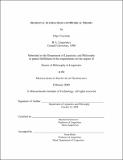Segmental alternations and metrical theory
Author(s)
Vaysman, Olga
DownloadFull printable version (3.667Mb)
Other Contributors
Massachusetts Institute of Technology. Dept. of Linguistics and Philosophy.
Advisor
Michael Kenstowicz.
Terms of use
Metadata
Show full item recordAbstract
This dissertation focuses on phonological alternations that are influenced or constrained by word-internal prosody, i.e. prominence and foot structure, and what these alternations can tell us about metrical theory. Detailed case studies of several cases of prosody sensitive segmental alternations, as well as a survey of such phenomena mentioned in the literature were the empirical basis for this study. I have offered an empirically motivated proposal that constituency and prominence have to be separate entities in the grammar, since some segmental alternations cannot be accounted for without reference to foot boundaries, while others require reference to prominence. The data also shows that there are languages with mismatches between stress assignment pattern and foot structure. Based on the empirical data that prosody-sensitive alternations provide, I develop the formal proposal of representation of prominence and foot structure and their interaction. Prominence is represented by gridmarks on an autosegmental tier, while foot structure is not built on the gridmarks, but is a function of syllables grouped into higher-level constituents. I propose that the relationship between foot structure and prominence should be mediated by violable constraints relating the two entities. I call them Prominence Alignment constraints. Mismatches between foot structure and prominence assignment in a given language are caused, under the present theory, when one of the constraints that refer to prominence but not to foot structure outranks a Prominence Alignment constraint. The factorial typology generated by such ranking is substantiated by the case studies throughout this dissertation. I argue that the model developed in this dissertation generates all types of interaction between foot structure and prominence attested and does not generate unattested patterns.
Description
Thesis (Ph. D.)--Massachusetts Institute of Technology, Dept. of Linguistics and Philosophy, 2009. Includes bibliographical references (p. 263-268).
Date issued
2009Department
Massachusetts Institute of Technology. Department of Linguistics and PhilosophyPublisher
Massachusetts Institute of Technology
Keywords
Linguistics and Philosophy.